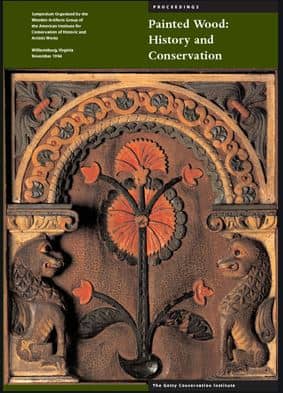‘Painted Wood History And Conservation’ PDF Quick download link is given at the bottom of this article. You can see the PDF demo, size of the PDF, page numbers, and direct download Free PDF of ‘Painted Wood PDF History And Conservation’ using the download button.
Painted Wood: History And Conservation PDF Free Download

Painted Wood History And Conservation
Among the vast array of tree species, the most familiar and most used woods are obtained from trees that we know as hardwoods and softwoods.
The angiosperms are grouped into two subclasses, the monocotyledons (which includes palms, rattans, bamboo, etc.) and the dicotyledons, the source of the woods we know as hardwoods.
The woods we call softwoods are from trees of the gymnosperms, principally in the order Coniferales; thus these trees are also known as conifers.
The traditional terms hardwood and softwood have no accurate reference to the relative hardness and softness of the wood, and should therefore be interpreted simply as designations for the two major botanical groups they represent.
Although tree stems of both hardwoods and softwoods have many similar characteristics of form and gross features, there are categorical differences of anatomical detail between the two groups of woods.
The tree has a main supporting stem or trunk, the portion most commonly used for lumber and veneer. When a cylindrical log is removed from the stem by crosscutting, the exposed ends of the log reveal the outer layer of bark.
Interior to the bark, and comprising the bulk of the stem, is the wood, characterized by its many growth rings arranged concentrically around the central pith.
Between the bark and the wood is a microscopically thin layer of living tissue, the cambium, whose cells divide during the growing season to produce new wood cells to the inside, bark to the outside Wood cells and tissues.
The cell is the basic structural unit of plant material, and, accordingly. wood tissue is the physical structure of countless cells. Wood cells are typically elongated, although the proportions of length to diameter vary
Cell structure
The most obvious diflFerences between hardwoods and softwoods are apparent when the cell structure of the two groups is compared.
Within either group, analysis of cell structure accounts for the extent of earlywoodlatewood variation within a single growth ring.
Figure 5a-d shows examples of the cell structure of representative softwoods and hardwoods.
Softwood cell structure
Among the softwoods, the bulk of the wood tissue (approximately 90% by volume) consists of longitudinal tracheids.
These cells are conspicuously elongated, with lengths of up to one hundred times their diameters, the lengths averaging from 2 to 7 mm among the various conifers.
Transverse sections (Fig. 5a-d, left-hand column) reveal that the tracheids occur in rather uniform radial rows, and that they are quite uniform in tangential diameter.
Among the conifers, the diameters of the tracheids are used as a relative measure of the texture of the woods.
Tracheid diameters range from an average of 60-70 ^m in the coarsest textured softwoods, such as baldcypress {Taxodium distichum) and redwood (Sequoia sempervirens), to an average of only 15-20 [xm in fine-textured softwoods, such as yew (Taxus spp.) and eastern redcedar (Juniperus virginiana).
Many softwoods, such as eastern white pine (Pinus strohus) and spruce (Picea spp.), have average tracheid diameters in the medium texture range of 30-40 \im.
It is apparent that the average diameter and cell-wall thickness of the earlywood tracheids will determine the physical surface configuration on machined wood surfaces and will thereby be related to the ability of a surface coating to fill or penetrate the wood surface.
Tracheids are largest in radial diameter in the earlywood.
Radial diameter decreases and cell walls become thicker toward the latewood portion of the growth rings, resulting in greater density and darker appearance of the latewood.
The extent of variation of radial diameter and cell-wall thickness determines the overall contrast in density between earlywood and latewood.
The lower density softwoods, such as eastern white pine and northern white cedar (Thuja occidentalis), have minimal change of density from earlywood to latewood.
These woods tend to have fairly uniform working properties, as well. The higher density softwoods, such as larch, Douglas-fir (Pseudotsuga menziesii), or southern yellow pine (Pinus spp., southern group), have thin-walled earlywood but strikingly thicker latewood.
The southern yellow pines, for example, typically average 0.5-0.6 specific gravity overall.
However, these values represent the average of earl)rwood of 0.3 specific gravity and latewood of up to 0.95 specific gravity.
This variation renders drastic differences in radial and tangential surfaces and the tissue exposed, and to paint applied to them.
| Writer | Getty Conservation Institution |
| Language | English |
| Pages | 549 |
| Pdf Size | 25 MB |
| Category | Art |
Related PDFs
Understanding Graphic Design Literacy PDF
Draw 50 Animals PDF With Simple Step
Drawing Comics The Marvel Way PDF
Painted Wood: History And Conservation Pdf Free Download
